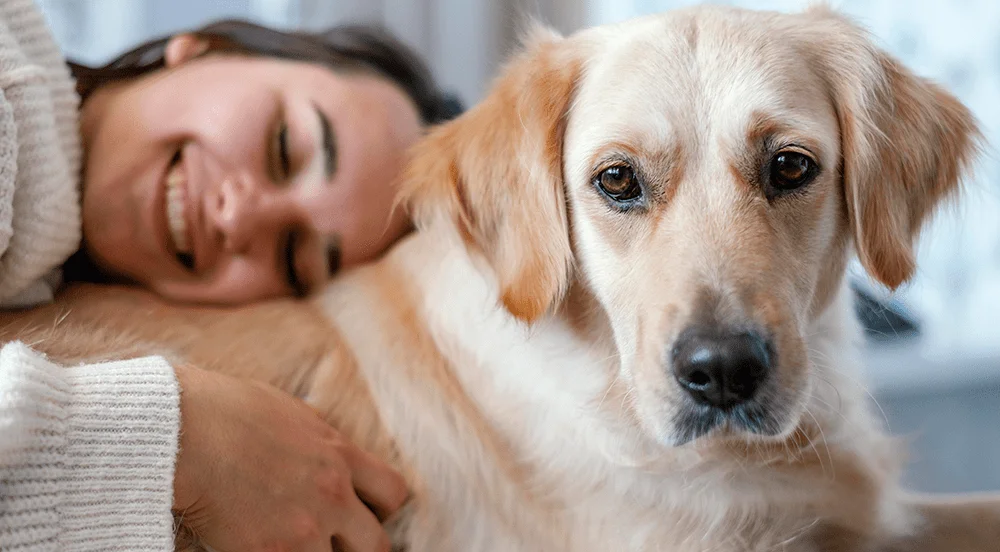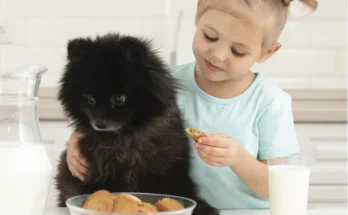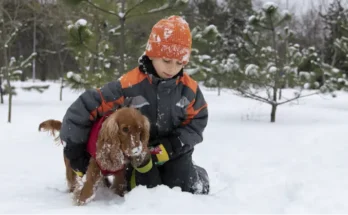No matter how much we pour affection onto our dogs, many of them are anxious creatures – easily spooked by a bird at the window, a passing pooch, or even a friendly neighbor at the door. It’s not unusual for your dog to get freaked out occasionally; in fact, a Finnish study of almost 14,000 dogs showed that an incredible 72 percent of them could be considered anxious. That’s a lot of nervous pups!
So How To Calm An Anxious Dog ? In this article, we go top to bottom about uneasiness in dogs and unload the absolute most normal reasons your dog may be restless. Assuming you might want to make quick work of your dog’s tense way of behaving, read on to get a few master tips and guidance for relieving their nerves and quieting them down.
Why is my dog anxious?
The purposes behind a dog’s nervousness are wide-coming – a few dogs are impacted by horrible encounters from quite a while ago, while for other people, the reason could be as straightforward as having an alternate dog food bowl than they’re utilized to.
Some scenarios will commonly unsettle a dog, however, and they usually include the following:
Change of environment – If you’ve recently moved house or renovated your home in some way, your dog may take a while to adjust to their new surroundings.
Other dogs or pets in the home – If your pooch has spent a while being the only dog you dote on, having unfamiliar dogs or new pets in the house may appear threatening until they get to know them better.
Strangers or new people – If you have a new partner, a new baby, or have unfamiliar people in the house, even a delivery person regularly knocking on the door, this can be frightening to naturally territorial dogs.
Dietary changes – Have you changed your dog’s diet recently? Perhaps they’ve eaten lots of treats or human leftovers? There’s a strong relationship between food and behavior (read on for more), and some foods can exacerbate a dog’s reaction to common stressors.
Noises caused by storms, building works, or fireworks – Lots of dogs hate loud noises, but if it’s a continual racket caused by the likes of neighbors, bad weather, or construction, your dog might suffer from sensory overload.
Crowds – Similarly, having a party in the house, or taking your dog to a place with lots of people and stimulation can be too much activity for them to handle.
Being left alone – Dogs form strong attachments to their owners, and if left alone without their dog parents for too long, they can develop separation anxiety.
Past experiences – The most restless of dogs have typically become so because of their previous encounters. At the point when dogs have been damaged before, they don’t feel as in every case protected as dogs who have had a safe, cherishing childhood.
A few varieties are inclined to tension – All dogs can be restless, yet a few varieties are more inclined to becoming nervous, and especially encountering abandonment when left be. These incorporate Line Collies, Bichon Frises, German Shepherds, and Cocker Spaniels.
Side effects of tension in dogs
If you don’t know how to distinguish whether your dog is feeling tension, that is all good – in some cases, it tends to be hard to separate whether your dog is frightened or energized. On the other limit, a few dogs become peaceful and removed when they’re restless, which could undoubtedly slip by everyone’s notice on the off chance that you’re occupied.
Normal side effects of tension in dogs, all things considered, include:
- Barking and whining more
- Tense body language, including quivering or cowering
- Becoming aggressive, hostile, or destructive
- Hiding away, or becoming quiet and withdrawn
- Digestive issues, such as excessive gas or going to the toilet in the house
- Low appetite, or stopping eating entirely.
The most effective method to quiet a restless dog
Seeing your dog in a condition of pressure, regardless of what the cause is terrible. All in all, what are the most ideal ways to quiet your restless dog, and know about their tensions so you can diminish its opportunity reoccurring? Here are a few hints and procedures to assist your dog with adapting to their strained feelings.
Tips to quiet a focused on dog
Assuming your dog is showing tension side effects, attempt to distinguish the reason and if conceivable, put a few distance between your dog and the stressor.
Take them for a walk or to enjoy some form of exercise like playing with a ball outside. The immediate change in surroundings and activity should calm them.
Soothe them with snuggles. While it’s important not to overly fuss, let your dog know you’re there to keep them safe by touching and stroking them. Mild massage of the face or back muscles may also help them to physically let go of tension.
Provide a safe space. Your dog should have a place to escape to when they’re overstimulated, such as a covered den or bed, or a room that’s quiet and cool so they can be alone. Ensure this place is always clean, airy, and smells good, without harsh lighting or distractions.
Apply mild pressure to your dog. Some dogs respond to pressure when stressed, such as from a weighted blanket or a dog anxiety wrap.
Play music. Particularly useful for separation anxiety, pleasant music such as classical, piano or harp music can be soothing for a dog and block out harsh noises.
Try simple commands. If your pooch won’t settle down, distracting them with simple training tasks can divert their attention. Reward them with a treat afterward.
Consider their diet Unbeknownst to their owners, some dogs are nervous because their diet has them feeling fidgety and uncomfortable. The gut and brain are intrinsically linked, so if your dog isn’t digesting their food properly or has an underlying allergy, such as grain or wheat, it could be causing them discomfort and distress.
How to calm an anxious dog at night
Is it at nighttime that your dog just won’t settle? If you have a pooch who gets spooked when it’s time to sleep, here are some tips to help them wind down each evening.
Stick to a bedtime routine. When a dog has a regular meal time, bedtime and place they usually sleep, they’ll want to sleep at the same time each night. If your pooch doesn’t have a bedtime routine, start one as soon as possible, because getting them to sleep will be much harder.
Keep a calm, safe sleeping area for your dog to rest in. A comfortable bed, cozy blankets, and a cool, dark environment each night should have them snoozing in no time.
Consider their feeding routine. Does your pooch eat dinner very close to bedtime? This means they’ll still be digesting food when it’s time to sleep, which could disrupt their sleeping patterns.
Use an oil diffuser. Lots of dog owners have had success using an oil diffuser, as the sweet smells gently send their dogs to sleep. Be sure to use diluted oil in a calming scent dogs appreciate, such as lavender.
Introduce a bedtime toy or blanket. If your dog has a toy you give them to snuggle specifically at bedtime, that toy will become a clever sleep trigger, letting them know that it’s time for bed. Over time, they may end up getting it out to let you know they’re sleepy.
How to calm dog anxiety naturally
The bond between dogs and owners is so strong that many form separation anxiety. If you’ve noticed your dog getting severely anxious each time you leave the house, or you return to a trail of mess and destruction each time your pooch has been left alone, there are some straightforward steps you can take to ease their distress.
Give your dog reasons to be entertained while you’re not around. This could be as simple as leaving a few treats hidden around the house, or placing a few toys or interactive dog puzzles around to distract them. Music is also particularly comforting to dogs, or you could even experiment with Dog TV. To be certain they remain comfortable, take them out for a walk so they can go to the toilet before you leave, and close curtains if you live on a road with passers-by.
If your pooch is racked with grief every time you go out without them, try not to leave them for too long. If you’re planning to go out for a while, get a trusted dog sitter to play with them and keep your devoted pooch company.
How to calm dog anxiety naturally
Heard of the gut-brain axis? Yep – it’s scientifically proven that even for dogs, stress and anxiety is intrinsically linked to activity in the gut. Therefore, there are plenty of ways to reduce anxiety through nutritional means to reduce anxiety – such as adding natural gut-boosting ingredients to your dog’s food or trying natural anti-anxiety supplements for dogs.
Try giving your pooch a boost of gut-supporting probiotics, either with probiotic supplements for dogs or with a calming dry food; it can help address the balance of friendly bacteria in their tum, instilling a sense of ease and well-being throughout their body and mind.
Or for a bite-size dose of calm that tastes great too, calming treats for dogs contain naturally soothing ingredients such as hemp, chamomile, and even turkey, which helps produce serotonin (the happy hormone) with its key amino acid, L-tryptophan.
What are the signs of anxiety in dogs?
An anxious dog may pant, pace, tremble, drool, withdraw from its owner, or hide. Alternatively, they may appear irritable or aggressive (i.e., bark or growl at someone). The dog’s tail may be low or tucked, ears back, eyes dilated, or showing lots of white around them (whale eye).
How to train anxiety out of a dog?
Use positive training methods only. Ignore and redirect unwanted behavior rather than punishing your dog. Using rewards will encourage your dog to build positive associations with the training process.
Can dog anxiety be cured?
Training techniques such as desensitization and counterconditioning are two strategies that can treat anxiety and fear. Desensitization is accomplished through repeated, controlled exposure to your dog’s specific fear or anxiety stimulus.



